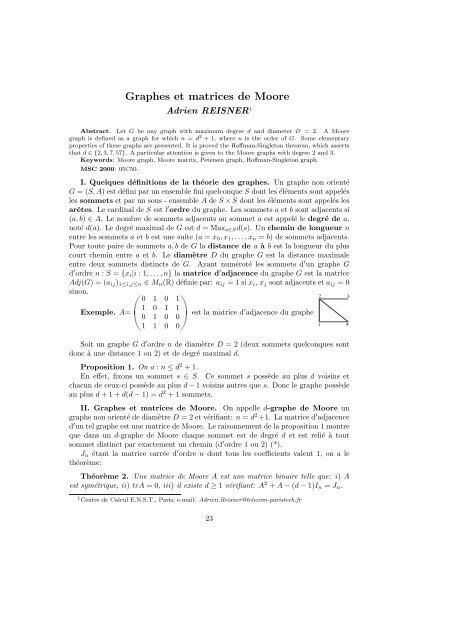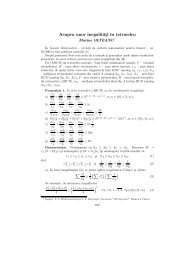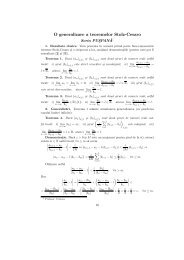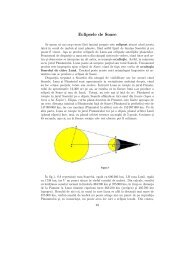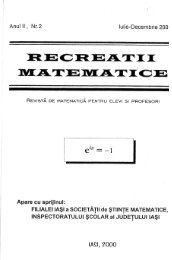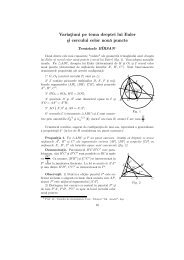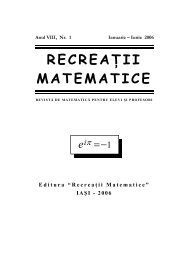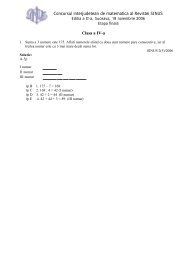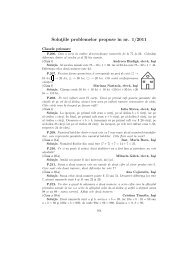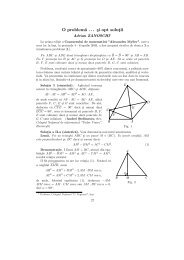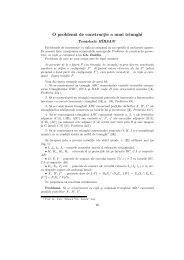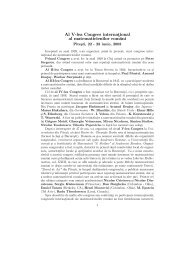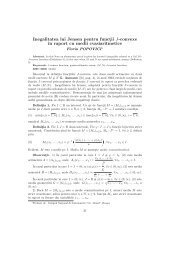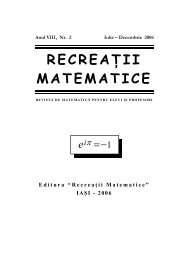Graphes et matrices de Moore
Graphes et matrices de Moore
Graphes et matrices de Moore
- No tags were found...
Create successful ePaper yourself
Turn your PDF publications into a flip-book with our unique Google optimized e-Paper software.
Soient E b <strong>et</strong> E c les sous – espaces propres associés aux valeurs propre b <strong>et</strong> crespectivement. Désignons par β = dim E b ∈ N ∗ . Il vient alors, la matrice A étantdiagonalisable <strong>et</strong> avec dim E d = 1: dim E c = n − 1 − β = d 2 − β. Exprimons qu<strong>et</strong>r A = 0 : d + βb + (d 2 − β)c = 0, avec β ∈ N ∗ . On obtient: d + β −1−√ 4d−32+(d 2 − β) −1+√ 4d−32= 0, d ′ où(1) (d 2 − 2β) √ 4d − 3 = d 2 − 2d soit β = d(2 − d) + d2√ 4d − 32 √ ∈ N 24d − 3β étant un entier non nul, on a d = 2 <strong>et</strong> donc β = 2, sinon p = √ 4d − 3 ∈ N ∗ . Larelation (1) montre alors que p divise d 2 − 2d = p2 + 34d 2 − 2d = p2 + 3· p2 − 5. Cela impose que p divise 15 soit que p ∈ {1, 3, 5, 15}. Les· p2 + 5, donc que 16p divise44 4seules valeurs possibles pour d sont donc finalement: d ∈ {2, 3, 7, 57} (Le cas p = 1,d = 1 doit être écarté car alors n = 2 <strong>et</strong> le diamètre est 1).Exemple. On se propose <strong>de</strong> trouver tous les 2-graphes <strong>de</strong> <strong>Moore</strong> (donc n = 5).Soit B = {e 1 , e 2 , . . . , e 5 } la base canonique <strong>de</strong> R 5 . Pour i, j, k, l, m ∈ {1, . . . , 5}, tousdistincts <strong>de</strong>ux à <strong>de</strong>ux, soit f un endomorphisme tel que Mat(f, B) = A ∈ M 5 (R) soitune matrice <strong>de</strong> <strong>Moore</strong>. Alors f est tel que: f(e i ) = e j + e k , f(e j ) = e i + e l , f(e k ) =e i + e m , f(e l ) = e j + e m , f(e m ) = e k + e l . Un simple raisonnement combinatoiremontre alors que le nombre N 2 <strong>de</strong>s 2-graphes <strong>de</strong> <strong>Moore</strong> est: N 2 = 2(3 + 2 + 1) = 12.Les douze 2-graphes <strong>de</strong> <strong>Moore</strong> (n = 5) sont les suivants:2213 4315452213 4315542411352 34 52411352 34 52511342 3542511342 3III. Applications. A. Graphe <strong>de</strong> Cayley d ′ un groupe fini. On considèreun groupe fini Γ = {g j } d ′ élément neutre 1 <strong>et</strong> K une partie génératrice <strong>de</strong> Γ vérifiant:K −1 = K <strong>et</strong> 1 /∈ K. On appelle graphe <strong>de</strong> Cayley du groupe associé à K le graphe. . .ẓ 1. .. .zz 12z0=1z 2.z0=1.z 3z 4z 3 z 45425
Cay(Γ, K) = (S, A) ainsi défini: S = {g j }, (g i , g j ) ∈ A ⇔ g −1i g j ∈ K. Soit le groupecyclique U 5 = {z j = e 2iπj5 } j:0,...,4 <strong>et</strong> K 1 = {z 1 , z 4 }, K 2 = {z 2 , z 3 }. Les graphes <strong>de</strong>Cayley Cay(U 5 , K 1 ) <strong>et</strong> Cay(U 5 , K 2 ) sont les <strong>de</strong>ux 2-graphes <strong>de</strong> <strong>Moore</strong> ci-<strong>de</strong>ssus.B. Matrice <strong>de</strong> Gram. Soit l ′ espace vectoriel euclidien R 5 rapporté à la baseorthonormée B = {e 1 , e 2 , . . . , e 5 }. On note < u, v > le produit scalaire <strong>de</strong> <strong>de</strong>uxvecteurs u <strong>et</strong> v <strong>de</strong> R 5 . On considère tous les vecteurs u j obtenus en ajoutant <strong>de</strong>uxvecteurs distincts <strong>de</strong> la base B: u j = e α + e β où α ≠ β. On obtient ainsi 10 vecteursdistincts <strong>de</strong>ux à <strong>de</strong>ux (en eff<strong>et</strong>, en utilisant le fait que la famille (e k ) k:1,...,5 est libreon a = 10 choix possibles). La matrice <strong>de</strong> Gram <strong>de</strong> la famille <strong>de</strong>s vecteurs (u j ) j:1,...,10est définie par: M = Gram(u j ) = (m ij ) ∈ M 10 (R) avec m ij =< u i , u j >. Calculonsles produits scalaires < u i , u j > en distinguant trois cas:1) < u i , u i >=< e α , e α > +2 < e α , e β > + < e β , e β >= 2 si u i = e α + e β ;2) < u i , u j >=< e α , e α > + < e α , e γ > + < e β , e α > + < e α , e γ >= 1 siu i = e α + e β <strong>et</strong> u j = e α + e γ , β ≠ γ;3) < u i , u j >= 0 si u i = e α + e β <strong>et</strong> u j = e δ + e γ α, β, δ, γ distincts.On vérifie alors immédiatement la proposition suivante:Proposition 6. La matrice A = J 10 − M + I 10 est une matrice <strong>de</strong> <strong>Moore</strong>. SpA ⊂Z ∗ .En particulier, i étant fixé, soit u i = e α + e β où α ≠ β. Si u j = e δ + e γ on am ij = 1 si <strong>et</strong> seulement si les quatre indices α, β, δ, γ sont distincts. Pour i donné ily a donc3 2=3tels coefficients: dans ce cas d = 3 (donc on a bien n = 10). Le3-graphe <strong>de</strong> <strong>Moore</strong> ainsi obtenu est un graphe <strong>de</strong> P<strong>et</strong>ersen - voir ce graphe ci-<strong>de</strong>ssous(la figure <strong>de</strong> droite).C. Configuration <strong>de</strong> Desargues. Soient ABC <strong>et</strong> A ′ B ′ C ′ <strong>de</strong>ux triangles sanssomm<strong>et</strong>s communs. Si AA ′ , BB ′ <strong>et</strong> CC ′ sont concourantes en I, alors les pointsCALI.CABBJKB.. . .LB. . . A K.A C.CJ.IJ = AB ∩ A ′ B ′ , K = BC ∩ B ′ C ′ <strong>et</strong> L = CA ∩ C ′ A ′ sont alignés: c ′ est le théorème26
<strong>de</strong> Desargues. Dans c<strong>et</strong>te configuration - configuration <strong>de</strong> Desargues - il y a 10droites <strong>et</strong> 10 points; par chaque point il passe 3 droites <strong>et</strong> sur chaque droite il y a 3points. On représente c<strong>et</strong>te configuration par un graphe G = (S, A). Les somm<strong>et</strong>s <strong>de</strong>ce graphe sont les 10 points <strong>de</strong> la configuration <strong>de</strong> Desargues. Deux somm<strong>et</strong>s i <strong>et</strong> jsont reliés par une arête si <strong>et</strong> seulement si les points correspondants ne sont pas surune même droite. On obtient ainsi le 3-graphe <strong>de</strong> <strong>Moore</strong>, i.e. le graphe <strong>de</strong> P<strong>et</strong>ersenG ci-<strong>de</strong>ssus.Remarque. Pour d = 2, d = 3 <strong>et</strong> d = 7 on a montré l ′ existence <strong>de</strong>s d-graphes <strong>de</strong> <strong>Moore</strong>: graphes <strong>de</strong> P<strong>et</strong>ersen pour d = 3, n = 10 (voir le site web:http://mathematiques.ac-dijon.fr/ressources/graphes/jca/intro.htm), graphes<strong>de</strong> Hoffman – Singl<strong>et</strong>on pour d = 7, n = 50. Par contre, l ′ existence d ′ un 57-graphe <strong>de</strong> <strong>Moore</strong> n ′ a pas été encore démontré: un tel graphe aurait 3250 somm<strong>et</strong>s.Références1. A.J. Hoffman, R.R. Singl<strong>et</strong>on - On <strong>Moore</strong> Graphs with Diam<strong>et</strong>ers 2 and 3, IBMJ.Res. Develop., 5(4)(1960), 497-504.2. S.V. Duzhin - <strong>Graphes</strong> <strong>de</strong> <strong>Moore</strong> (démonstration <strong>de</strong> Chmutov),http://www.pdmi.ras.ru/ duzhin/papers/ .3. R.A. Brualdi , H.J. Ryser - Combinatorial matrix theory, Cambridge UniversityPress, 1991.(continuare <strong>de</strong> la pag. 22)Deci nu putem avea <strong>de</strong>cât A + B + C = 18 care, coroborată cu condiţia a doua aipotezei, impune rezultatului să fie format din cifrele 5, 6 respectiv 7, nu neapărat înaceastă ordine.Să găsim toate posibilităţile. Mai întâi, observăm că dacă schimbăm a cu a ′ , bcu b ′ şi c cu c ′ rezultatul nu se modifică (transformarea 1). Asta însemnă că, dacăfixăm un ”exemplu reprezentativ” (să zicem a < a ′ , b < b ′ şi c < c ′ ), se obţin 2 3posibilităţi. Apoi, observăm că, dacă are loc abc + a ′ b ′ c ′ = ABC, atunci are locşi bca + b ′ c ′ a ′ = BCA (transformarea 2). Asta înseamnă că pentru un exemplureprezentativ obţinem 2 · 2 3 = 16 posibilităţi.Următoarele două exemple sunt reprezentative 128+439 = 567 şi 218+439 = 657.Pentru primul exemplu obţinem: 128 + 439 = 567, 138 + 429 = 567, 129 + 438 = 567,139 + 428 = 567, 428 + 139 = 567, 438 + 129 = 567, 429 + 138 = 567, 429 + 138 =567 (conform transformării 1), la care aplicăm transformarea 2: 281 + 394 = 675,381 + 294 = 675, 291 + 384 = 675, 391 + 284 = 675, 284 + 391 = 675, 384 + 291 = 675,294 + 381 = 675, 294 + 381 = 675 - în total 16 posibilităţi. Analog pentru celălaltexemplu reprezentativ. Avem 2 · 16 = 32 posibilităţi.27


